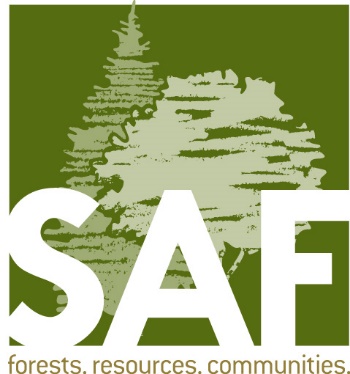Login to Complete an Application or to Access Judging Panel

SAF Fellow Award
The SAF Fellow Award is a prestigious award that recognizes an SAF member for long-standing service to forestry at the local, state, and national level. The SAF Fellow is recognized as an ambassador for the advancement of forestry.
The Fellow Award recognizes extraordinary contribution to forestry through: (1) a strong continuing commitment through direct SAF volunteer activities; (2) exemplary action and sustained leadership; and (3) advancement of the forestry profession in at least one of the following areas: (a) application of forestry, (b) education, (c) public policy, (d) research, or (e) technology transfer.
Members selected as Fellow are recognized during their local state society meetings with a certificate. Newly elected Fellows receive a complimentary ticket to the Fellow’s Breakfast at the SAF National Convention.
Eligibility
- Nominees must be professional members in good standing.
- Self nominations are not allowed.
- Work performed for SAF, directly or indirectly, cannot be counted toward volunteer service.
Criteria
Nominees must demonstrate the following:
- Significant number of years of sustained commitment to SAF volunteer activities, performed at two or more of the following SAF organizational levels: chapter; division; state; regional (multi-state or voting district); or national.
- Exemplary action and sustained leadership over many years in advancing the forestry profession at two or more of the following organizational levels: local; regional; national; or international.
Exceptions may be made for unusually notable contributions to SAF or to the forestry profession over a shorter time frame.
Nomination Review
Fellow candidates will be evaluated by a District Fellows Committee (DFC) established in each SAF voting district. All nominations the DFC deems qualified will be forwarded to the national Committee on Professional Recognition (CPR) to ensure nomination packets are complete and nomination procedures followed. The Committee on Professional Recognition will forward nominations, as a final recommendation, to the SAF Board of Directors for approval.
The committee will utilize a set of questions including, but not limited to, the following when reviewing the candidate’s qualifications.
Criterion #1 – Commitment to SAF
- Did the nominee serve as a recognized leader on SAF committees, boards, task forces, or editorial boards making innovative and effective contributions in the service of the profession? If so, how did the involvement impact SAF?
- Did the nominee serve as an elected officer at the local level such as chapters, divisions, state societies, or national level such as working group officer, Board member, SAF president, House of Society Delegates officer or Student Executive Committee? If so, how did the involvement impact SAF?
- Does the nominee collaborate with colleagues to enhance forestry through special SAF service including, but not limited to, accreditation site visit teams; reviewer for journal and other publications; ad hoc committees; representative to HSD; Student Executive Committee; faculty advisor; working group officer and member activities; or national or local leadership training?
- Did the nominee serve as a mentor or ambassador by encouraging other members or non-members toward SAF involvement or membership? Did the nominee promote diversity, equity, and inclusion within SAF and the forestry profession?
- Did the nominee’s volunteer activities occur at two or more of the following SAF organizational levels: local (chapter); state; regional (multi-state or voting district) or national?
Criterion #2 – Exemplary Action
- Does the nominee demonstrate professionalism impacting forestry in two or more of the following levels: local; state; regional; national; or international?
- Is the nominee recognized by numerous colleagues as a passionate leader who helps to raise the profession to a higher standard?
- Did the nominee demonstrate outstanding contributions in one of the following categories?
- Application of Forestry (including but not limited to)
- Uses science along with the adaptive management process to achieve landowner objectives and ensure forest sustainability;
- Management intensity may range from very intensive applications to more extensive management regimes; and
- Demonstrates the ability to work with colleagues to achieve management objectives.
- Education (including but not limited to)
- Demonstrates innovation in education by inspiring, producing, adapting, modifying, or developing functional and effective curriculum materials in conservation education or academic programs;
- Promotes excellence in teaching as demonstrated through the success of students; and
- Incorporates research practices in the development of curriculum and to improve teaching and student learning.
- Public Policy (including but not limited to)
- Demonstrates the ability to communicate sound forest management practices to local, state, or national legislators;
- Encourages involvement of professionals in forest policy issues;
- Demonstrates the ability to impact forest policy to ensure sound forest management practices; and
- Demonstrates involvement with local or state legislative commissions or advisory boards that promote sound forest management practices.
- Research (including but not limited to)
- Encourages high standards of research;
- Publishes in refereed publications;
- Shares research through presentations at professional meetings; and
- Exhibits involvement in the research of others as a subject or collaborator as dictated by the needs of the research.
- Technology Transfer (including but not limited to)
- Demonstrates how technology transfer activities affected the manner in which forestry is practiced;
- Demonstrates the ability to use a variety of techniques to transfer information; and
- Works with a variety of professional organizations and groups to share technical information concerned with the management of forest resources.
Nominations
Nominations can be made by an SAF member in good standing. Nomination packets must contain all of the following documents:
- Nomination/consent form;
- Three endorsement forms from three individuals that address the nominee’s accomplishments;
- Completed biographical and professional information form or curriculum vitae; and
- Recent digital photo with a minimum of 300 dpi.
Documents